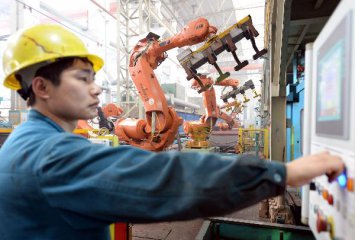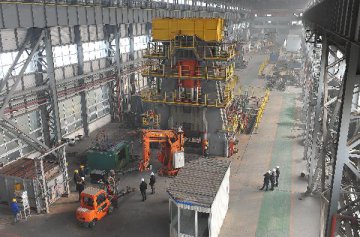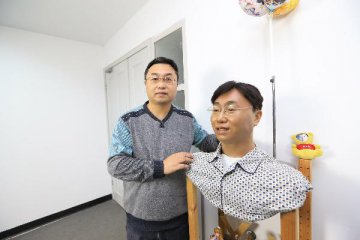
China’s economic growth rate was 6.9 percent in 2015, with GDP totaling at 67,670.8 billion yuan, which should be a prideful figure in the world. But in the same period, its corresponding national fixed assets investment (excluding peasant household) was 55,159 billion yuan. Comparison of these two figures shows China’s economy has operated with “problems”, which also explains the new measure for the economy taken by the central government at the end of last year, motivation for supply-side structure reform.
Efficiency “submerged” by surplus capacity
Areas of China’s commercial residential building for sale reached 718 million m2 in 2015, showed by data of the National Bureau of Statistics (NBS) yesterday. What does it mean? These “vacant houses” can meet the demands of nearly 240 million people, provided that per capita living space is 30 m2 in China.
Recent years, areas of commercial residential building for sale have constantly expanded from less than 200 million m2 in 2010 to over 600 million m2 in 2014 according to historic statistics.
“It did not expect such large-scale of real estate stock, which increased 100 million m2 again last year, moreover, sales are evidently divergent to investment, and rebounded real estate sales did not incent related investment,” said Zhang Liqun, macro-economic researcher of Development Research Center of the State Council.
Data shows real estate investment constantly went down last year, and accumulative growth rate nationwide fell back to 1 percent, regarded as one of main factors for economic downtrend by analysts.
In terms of capacity, we have mentioned a lot about traditional industries, such as steel, concrete and building materials. However, traditional industries indeed struggle for survival, showed by a group of comparison data from 2015 annual economic report.
Last December, growth rate of mining industry was only 1.4 percent, far away from average production growth rate of 5.9 percent in the same period, according to industrial added value, while hi-tech industries maintained a growth rate of over 10 percent.
In terms of investment, steel industrial investment dropped by 11 percent for the whole year of 2015, with that of over 14 percent for coal industry, but those for industries of computer, electronic and communication device manufacturing increased 13.3 percent year-on-year in the same period, with a growth of nearly 12 percent for pharmaceutical industry.
“One side is hot, and the other is cold,” NBS press spokesman Sheng Laiyuan analyzed, “situation of traditional industries represented by steel and concrete is getting worse, but emerging industries meeting national industrial guidance continue to keep a growth rate, and such difference and adjustment are part of upgrading, which is a process from quantitative change to qualitative change.”
A few days ago, various listed steel companies disclosed loss forecast report for 2015. They all mentioned increasingly worse imbalance between supply and demand triggers the decline in product price and sales when explaining reasons causing losses. Zhang said to SSN journalist, “current capacity factor of steel and coal is 50 percent, but normal one should be over 80 percent, so it must be reduced.”
Many analysts mentioned in the interview that surplus capacity concentrates in state-owned enterprises (SOEs), as SOEs have penetrated deeply in traditional industries, accumulating most surplus capacity. One of the keys for SOEs reform is to defuse surplus capacity and clear up those “zombie enterprises”.
SOEs suffered the largest decline rate in profit last year, showed by statistics data. From January to November of 2015, profit of the SOEs dropped by 23 percent compared to that of 2014, but private enterprises maintained a growth of 5.3 percent in the same period.
Pains from de-capacity to continue
GDP growth rate was 6.9 percent last year, setting a new low since 25 years before. In terms of economic trend this year, the growth rate will possibly continue to slow down according to many analysts.
The Central Economic Working Conference last year determined a core for five major tasks, “de-capacity, de-stock and de-leverage”, and it will potentially have a negative impact on economy to a great extent, if the core is carried out; therefore, economic growth rate is expected to further slow this year, mentioned by Zhang Jun, chief economist of Morgan Stanley Huaxin Securities, in the SSN interview.
Lian Ping, chief economist of Bank of Communications, also agreed with this. He stressed measure taken for surplus capacity is one major factor when analyzing downtrend pressure.
Lian pointed out, “surplus capacity will be solved phrase by phrase in the future, de-capacity will pull down 0.3 percentage points of GDP annually based on conservative estimation, if several industries with severe surplus capacity will reduce 30 percent of the total capacity with a term of three years and 10 percent for each year, and these industries cover steel, concrete, coal and etc.”
However, “de-capacity will benefit medium and long term economic development, although it brings downtrend pressure on economy in a short term”, emphasized by Lian.
For many years, we hope to get rid of dependence on export and investment, and form three major driving forces to synergistically incent the economic development. It came true last year, although it might be forced by de-capacity and declined real estate investment.
NBS data also shows consumption contributed to 66.4 percent of economic growth last year, greatly up by 15.4 percentage points compared to that of a year earlier. But it cannot be denied consumption has become the first drive for economic growth.
Meanwhile, industrial economy slides. Service industry rapidly grows, accounting for over 50 percent of the GDP. Industrial structure comes across the turning point with changes. The economy will depend on service industry in the future.
“It indicates economy will rely on service industry and consumption, with related sustainable structure increasingly emerged, which also lays fundament of economic stabilization in the future,” said Zhang Liqun.
New momentum is gathering strength
Though the term of “supply-side reform” is newly created, the notion has been applied in the administration of this government long ago.
NBS head Wang Bao’an emphasized on the news press held yesterday (Jan. 19) that aiming at the overcapacity and economic downward pressure in China, the central government has taken a string of measures to stabilize growth, propel reform, adjust structure, benefit people’s livelihood and prevent risks, which play a great role in stabilizing employment, optimizing industrial structure and promoting the development of new economy.
It is noteworthy that latest data shows that traditional industries are really undergoing capacity reduction. Their growth rates and absolute output both declined. For example, the output of steel products recorded 95.28 million tons, or a year-on-year decrease of 3.4 percent; the output of cement recorded 197.97 million tons, moving down 3.7 percent in last December.
An anonymous source indicated that “it might imply that some traditional industries finally cannot stand it anymore and are actively decreasing capacity and clearing stocks. In fact, it’s hard for local governments or enterprises to cut capacity on their own due to factors including employment.”
Zhang Liqun believes that the ailing economy will be improved through supply-side reform in 2016 which is the starting year of the supply-side reform.
Translated by Jelly Yi and Jennifer






















Latest comments